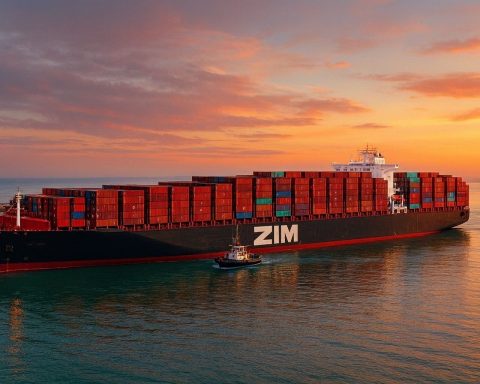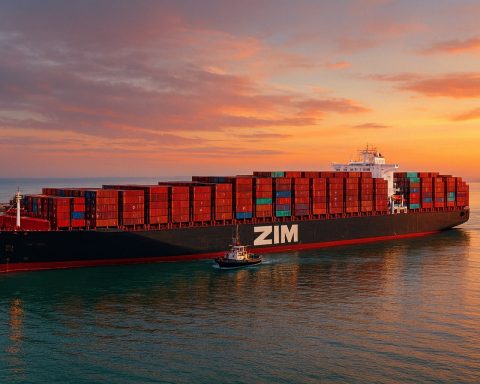Imbituba, Santa Catarina – On 25 November 2025, new data confirmed that the public Porto de Imbituba has just had its strongest month of the year and one of the most significant performances in its recent history, consolidating its role as a strategic logistics hub in southern Brazil.
From January to October 2025, the port handled 6.17 million tons of cargo across 268 ship calls, with October alone reaching 714.7 thousand tons – the highest monthly volume of the year so far. [1]
Record October crowns a year of sustained growth
According to figures disclosed by the port authority and reported by regional and national outlets, October was not just another busy month: it was the peak of 2025 so far for Porto de Imbituba. The terminal received 27 vessels in October, combining solid bulk, containerized cargo and transshipment operations in a single record month. [2]
In the ten‑month period:
- Total cargo handled: 6.17 million tons
- Ship calls: 268
- Best month: October, with 714.7 thousand tons moved
The performance keeps the port on track to exceed 7 million tons by the end of the year, a target mentioned by state authorities and port management as realistic if current trends are maintained. [3]
Financially, the movement of goods through Imbituba is also significant: between January and October, foreign trade operations via the port surpassed US$ 1.44 billion, underlining the terminal’s weight in Santa Catarina’s trade balance. [4]
Exports, imports and coastal shipping all climb
Behind the headline numbers is a diversified mix of cargo that explains why Imbituba has become more relevant on Brazil’s port map.
Export front: energy and agribusiness
From January to October 2025, exports totalled around 2.53 million tons. The main products shipped through the port were: [5]
- Petroleum coke (calcined and non‑calcined) – a key input for heavy industry and metallurgy
- Corn meal (farelo de milho) – linked to Brazil’s strong agribusiness chain
These cargoes help connect producers in southern Brazil with industrial clients and feed markets overseas.
Imports: industrial inputs and energy security
On the import side, Imbituba handled about 2.86 million tons in the first ten months of 2025, a 2.5% increase compared with the same period in 2024. [6]
The highlight was October, when the port registered just over 406 thousand tons of imported cargo in a single month – the highest import volume in its operational history. The main imported products included: [7]
- Bituminous coal (hulha betuminosa)
- Salt
- Industrial inputs for manufacturing and processing industries
This combination of energy inputs and raw materials strengthens the port’s role in supporting regional industry and electricity generation.
Cabotage and transshipment: Imbituba as a logistics hub
Growth was not limited to long‑haul trade. Cabotage – domestic coastal shipping between Brazilian ports – also expanded. From January to October, coastal flows via Imbituba reached approximately 547.3 thousand tons shipped and 136.8 thousand tons received, representing a 3.8% increase over 2024. [8]
Transshipment operations – when cargo is transferred between vessels at the port – more than doubled in 2025. In total, transshipment moved around 100.9 thousand tons, with about 56 thousand tons shipped and 44.9 thousand tons received, an increase of over 113% compared with the previous year. [9]
The result is a port that no longer serves only as an origin or destination, but increasingly as a distribution and consolidation point in coastal and regional routes.
Bulk cargo still dominates, but containers gain ground
Porto de Imbituba remains heavily oriented toward dry bulk, but the cargo profile is becoming more balanced.
- Solid bulk cargoes – such as coal, salt, sugar and grain products – accounted for around 77.8% of total throughput between January and October.
- Containerized cargo reached about 1.06 million tons, equivalent to 17.3% of the port’s overall volume, signalling a growing share of higher value‑added goods. [10]
For logistics operators and exporters, the rise in containers is significant. It means more opportunities for diversified cargo – from manufactured products to refrigerated goods – to take advantage of Imbituba’s deep‑water access and improving infrastructure.
ESG leadership: Cidesport award recognises sustainability push
The operational momentum in 2025 comes on the heels of an important recognition in the field of sustainability. On 25 November, Porto de Imbituba was announced as the winner of the 1st Cidesport Award for Best ESG Performance, in the category for public ports handling between 5 and 20 million tons per year. [11]
The prize evaluated 58 indicators related to environmental, social and governance practices, including:
- Environmental monitoring and control
- Management of people and workplace safety
- Integrity, transparency and governance mechanisms
According to the organisers, participating ports had to present data and evidence and then undergo an independent audit to validate the information. The result highlights a long‑term effort by the Santa Catarina state‑controlled authority, SCPAR Porto de Imbituba, to align operations with ESG best practices. [12]
Among the initiatives that supported the award are more than 20 active environmental programs, focusing on water and air quality, marine fauna and waste management on the waterfront. [13]
One of the most emblematic fronts is the monitoring of southern right whales, a symbolic species for the region. The port has maintained whale monitoring for 17 years and, during the Cais 3 construction works, uses alert zones and temporary stoppages of impact equipment whenever animals are detected near the worksite. [14]
R$ 95 million Cais 3 modernization will allow 270‑metre ships
Operational performance in 2025 is also supported – and in part explained – by a major infrastructure program underway. Cais 3, one of the port’s main berths and currently responsible for roughly 30% of its operations, is undergoing the largest structural intervention since it was built in 1979. [15]
Key points of the project include:
- Investment: approximately R$ 95 million
- Completion target: 2027
- Berth length: extension from 245 metres to 271 metres
- Vessel size: capacity to receive ships of up to 270 metres in length, compared to the current limit of around 200 metres
The modernization covers structural reinforcement, quay extension, new operational equipment and upgrades to paving, drainage and mooring systems. The works are being carried out by Cejen Engenharia, with project management by Estel Engenharia, both contracted through public tender. [16]
Because of the complexity of the intervention, one of the later phases will require a temporary suspension of operations at Cais 3 for up to five months, a period the port authority is reviewing to minimise impacts by adjusting schedules and optimising other berths. [17]
Even with this challenge, the expectation is that the project will significantly increase the port’s capacity in both volume and types of cargo, making Imbituba more competitive for global shipping lines and Brazilian exporters once the works are completed. [18]
Part of a broader boom in southern Brazilian ports
Imbituba’s numbers are not an isolated case. Recent data from Brazil’s National Waterway Transport Agency (Antaq), reported by industry outlet Guia Marítimo, show that public ports in the southern region (Paraná, Santa Catarina and Rio Grande do Sul) grew 14.02% in cargo movement in the third quarter of 2025 compared with the same period in 2024. [19]
While large complexes such as Paranaguá and Rio Grande lead in sheer volume, Imbituba’s combination of:
- Record October movement
- Growing container share
- Strong cabotage and transshipment figures
- A R$ 95 million berth upgrade
- And a national ESG award
positions the Santa Catarina port as a rising player in Brazil’s logistics chain, especially for companies looking for deep‑water access, operational agility and a sustainability‑oriented governance model.
With more than 6.17 million tons handled in ten months, a realistic chance of surpassing 7 million tons in 2025 and heavy investment in infrastructure and ESG, Porto de Imbituba enters the final stretch of the year not only breaking its own records, but also reinforcing its status as one of the most promising public ports in the country’s South.
References
1. www.portosenavios.com.br, 2. scempauta.com.br, 3. scempauta.com.br, 4. scempauta.com.br, 5. www.portosenavios.com.br, 6. www.portosenavios.com.br, 7. www.portosenavios.com.br, 8. scempauta.com.br, 9. scempauta.com.br, 10. www.portosenavios.com.br, 11. www.portalinfosul.com.br, 12. www.portalinfosul.com.br, 13. www.portalinfosul.com.br, 14. rdmonline.com.br, 15. amanha.com.br, 16. amanha.com.br, 17. amanha.com.br, 18. amanha.com.br, 19. www.guiamaritimo.com.br










